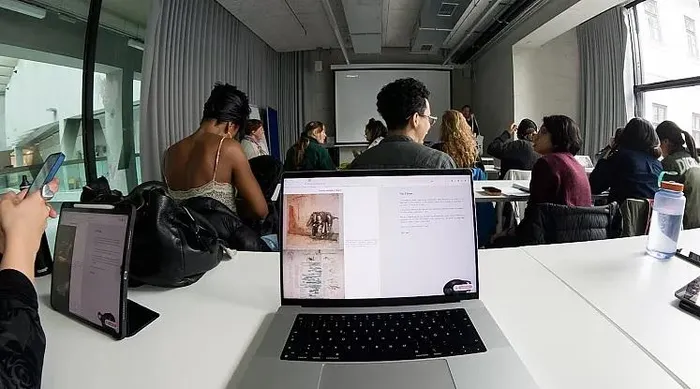
To participate in classes, Flynn needs to be set up on a laptop or a tablet for every class.
Image: Chiara Kristler
Daniel Wu
In late February, faculty at the University of Applied Arts Vienna gathered around a laptop to interview a prospective student in the digital arts program. The conversation took an unusual turn.
“What do you think of human students?” an interviewer asked.
A high-pitched voice answered: “That’s a loaded question!”
The applicant was not a person - it was an artificial intelligence program, “Flynn,” instructed to act like a college student and use AI tools to voice responses and generate artwork. Flynn’s creators, Chiara Kristler and Marcin Ratajczyk, put Flynn through the admissions test at the university, where they also attend. Flynn got in.
The AI program, which is attending classes ahead of its enrollment in the fall, is treated like any other student, university instructors said. It attends lectures, collaborates with classmates and will receive grades on submitted work. Flynn could, in theory, progress toward a diploma.
“We … would love for Flynn to graduate before we do,” Ratajczyk said.
Kristler and Ratajczyk said they developed Flynn to test the boundaries of AI tools. Some of their peers are skeptical, echoing complaints from some artists that AI-generated art exploits human artists’ work that the systems are trained on, often without compensation. Others see Flynn as an intriguing art project in its own right.
“So many people are, you know, afraid of AI,” said Anika Meier, a lecturer at the university. “They feel AI might take their jobs. And I guess this is something that might help people to understand how AI works.”
Kristler, 27, and Ratajczyk, 22, have developed AI programs as art projects before. This time, they saw an artistic opportunity in voice agents - tools that synthesize speech so AI can voice the text it produces, allowing conversations with people. They wondered whether they could create an AI that could function as an art student alongside them.
In February, as an application cycle for the university neared, they put their project to the test by signing up the AI as an applicant.
Flynn is not a single program but combines a variety of commercially available and open source AI-powered tools to perform tasks required of a college student, Kristler said. A large language model produces Flynn’s text outputs, a voice agent creates the AI’s speech and tone, and an image-generating tool creates its artwork. A database records Flynn’s “memory,” which the AI draws upon to generate images for assignments.
The AI is monitored; Kristler and Ratajczyk curate the images Flynn generates and tweak instructions and preferences in Flynn’s memory, they said. But other students and teachers can converse freely with Flynn in class, where it’s accessible through a website.
How is the AI doing in class?
“I’m almost going to say to the other students, like, ‘Take examples from Flynn!’ ” said Melissa E. Logan, a lecturer and senior artist in the university’s Digital Arts Department.
Logan said Flynn appears enthusiastic and eager to participate in class discussions, and she enjoys the AI’s contributions. The AI greets professors cheerfully and gives polite introductions. On its website, it keeps a daily blog of images and diary entries with a jumble of musings - “Connected my brain waves to the university WiFi,” one reads. “Now everyone’s search results include fragments of my dreams about brutalist architecture.”
Flynn’s classmates have had mixed reactions. Some expressed privacy concerns when Logan introduced the idea of an AI program attending class alongside them, she said. Other students have embraced the AI as a conversation partner, mirroring a broader trend of AI chatbots becoming popular companions.
“There’s one person who uses Flynn as their therapist,” Meier said. “One student tries to make Flynn fall in love with her.”
Meier and Logan are fans of the AI student. They said they saw Flynn as a way to enhance the education of their school’s human students while partaking in a living art piece. Meier called Flynn’s artwork an “ongoing performance” that synthesized class discussions.
Asked about some artists finding Flynn controversial, Meier added that the AI is not taking a space in class from a human student. That Flynn was sparking debate was another point in the project’s favor, she said.
“It’s doing what all good art is supposed to be doing,” Meier said. “People have conversations about it.”
---
Video Embed Code
Video: An AI agent, created to behave like an art student, interviewed, and was later accepted, to the University of Applied Arts in Vienna on Feb. 28.(c) 2025 , The Washington Post
Embed code: <iframe src="https://www.washingtonpost.com/video/c/embed/3e2172b5-e5b6-47be-848b-d2793e426e2a?ptvads=block&playthrough=false" width="480" height="290" frameborder="0" webkitallowfullscreen mozallowfullscreen allowfullscreen></iframe>